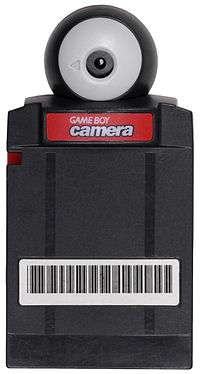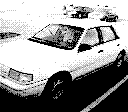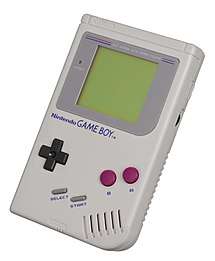Game Boy Camera
 A red Game Boy Camera. Various other colors were also available. | |
| Manufacturer | Nintendo |
|---|---|
| Product family | Game Boy line |
| Type | Video game accessory |
| Generation | Fourth generation |
| Release date | |
The Game Boy Camera (GBC), released as Pocket Camera (ポケットカメラ) in Japan, is a Nintendo accessory for the handheld Game Boy gaming console and was released on February 21, 1998 in Japan, which ceased manufacture in late 2002. It is compatible with all of the Game Boy platforms (including Super Game Boy and with the exception of Game Boy Micro). The camera has a 128×128 pixel CMOS sensor,[2] [3] and can store 128×112, black & white digital images using the 4-color palette of the Game Boy system. It interfaced with the Game Boy Printer, which utilized thermal paper to print saved images, making a hardcopy. Both the camera and the printer were marketed by Nintendo as light-hearted entertainment devices aimed mainly at children in all three major video game regions of the world: Japan, North America, and Europe. N64 Magazine (which has since been superseded by NGamer) dedicated a monthly section to the device.
The Game Boy Camera comes in five different standard colors: blue, green, red, yellow and clear purple (Japan only). There was also a limited edition gold The Legend of Zelda: Ocarina of Time edition, which contains different stamps from the standard versions and was available only in the United States through a mail order offer from Nintendo Power.
The device's software has numerous references to other Nintendo products. Also, there are a few differences between the North American and Japanese versions, including the unlockable B album pictures and the stamps that can be placed on pictures.[4]
The Game Boy Camera (GBC) was featured in the 1999 edition of Guinness World Records for being the world's smallest digital camera, though this record has since been broken.[5] Nintendo reportedly had plans to release a successor to the Game Boy Camera for the Game Boy Advance called the GameEye[6] which would take color photos and feature connectivity with the Nintendo GameCube through a game titled Stage Debut, but neither the GameEye nor Stage Debut saw release. Nintendo has had built-in cameras with the Nintendo DSi and Nintendo 3DS.
Features

There are three visible options available on the home screen: Shoot, View, and Play.
There is a fourth set of options that are shown when the SELECT button is pressed. A fifth, hidden menu appears when the user presses the START button.
SHOOT option (from home screen)
- SHOOT - Shoot Mode, where individual pictures can be taken
- ITEMS
- SELF-TIMER sets a delay timer for taking pictures
- TIME LAPSE provides an intervalometer function
- MAGIC
- TRICK LENSES - image mirroring, scaling
- MONTAGE - create multi image photos
- PANORAMA - create a panorama with multiple shots
- GAME FACE - edit game face photos
- CHECK - view/edit saved photos in a sequential "film roll" format
- RUN - loads a silly screen
VIEW option (from home screen)
- ALBUM - view/edit photos in a non-sequential "photo album" format
- SHOW - SLIDE SHOW, ANIMATION and HOT-SPOT features
PLAY option (from home screen) -see Minigames below
SELECT button (from home screen) - various photo editing functions
- DOODLE - add various stamps to pictures
- STAMP - use stamps on pictures
- PAINT - draw freely on pictures
- LINK
- PRINT - select photos for printing
- TRANSFER - send photos to another GBC
- SEND pictures to another GBC
- RECEIVE pictures from another GBC
- SPECIAL
- HOT-SPOT - create hot spot trigger points in photos which jumps to another photo
- COMPOSE
- SPLIT - Divide photos
- FUSION - combine photos
- EDIT
- ALBUM - delete photos directly from the album view
- ANIMATION - combine photos into animations
Users can make photo albums, slideshows, and custom animations of photos.
START button (from home screen) - personalization and record viewing options
- USER NAME allows the user to enter their name, birthday, and gender
- RECORD shows statistics of photos taken, transferred to and from the GBC, and deleted
- HI-SCORE shows top mini-game scores
- CREDITS shows staff credits, but only after being unlocked (see below)
Hot-Spot
Hot-Spot allows users to link pictures together by clicking on certain spots of the picture. This can be used in a number of creative ways. For example, it could be used for creating a game where a player can go from one photo of a room in a house to another by pressing certain spots on the photos. The location of the hot-spots are customizable by accessing the Special menu via the Select options and choosing "Hot-Spot". In this mode, up to five one-eyed blobs can be placed on each picture, which become invisible hot-spots during "Hot-Spot" mode. Each blob can be programmed to send the player to a different photo and include a visual transition and a sound effect. Then, in Hot-Spot mode, when the player presses one of the hot-spots, he or she will be sent to a photo of another room, where additional hot-spots will send the player to additional photos, and move him or her throughout the virtual house.
The Japanese version of the device is optionally integrated into the Mario Artist suite of multimedia games for the 64DD peripheral. Users can create drawn and 3D-animated avatars of themselves based on photographs taken with the camera.[7]
Minigames
Play is a built-in Space Fever II minigame,[5] which is the sequel to the Space Fever arcade game created by Nintendo. At the beginning of the game, two spaceships appear, one marked with a "B" and one with a "D". Shooting the "B" ship will send players to the Ball minigame. Shooting the "D" ship will send players to DJ mode, an open-ended music video game. By avoiding both of the ships, the player will begin playing Space Fever II. After scoring 2,000 points in Space Fever II, a new minigame called Run! Run! Run! will be unlocked. Once unlocked, a new ship marked with a "?" will appear alongside the "B" and "D" ships at the beginning of each new game of Space Fever II. Access Run! Run! Run! by shooting the "?" ship.
- Ball is a juggling game, in which the player moves his or her hand around to catch and throw balls. It is very similar to the Game & Watch game of the same name, only with Mr. Game & Watch's head replaced with the "Game Face". The background music to this game is "Mayim Mayim," an Israeli folk song.
- DJ is a music sequencer known as Trippy-H where players can mix and create their own simple chiptunes. The "Game Face" is the DJ.
- Space Fever II is an homage/sequel to an early Nintendo arcade game. In this minigame, the player controls a spaceship which fires missiles at other ships throughout three unique levels, followed by a boss at the end of each level. The first boss is a giant face of a man with horns, the second boss is a giant face of a mustachioed man, and the third boss is the "Game Face". Once all three of the bosses are beaten, the cycle will start over again, only harder.
- Run! Run! Run! is the bonus minigame, which is obtained by reaching a score of 2,000 or more in Space Fever II. The "Game Face" is attached to a cartoon body, and the player races against a mole and a bird for the finish line. By clearing this minigame in under 22 seconds, the credits are unlocked.
Easter eggs
The Game Boy Camera's software came with a few Easter eggs.
- If the "Run" button was pressed while the user was on one of menu screens, the game would sometimes freeze, and an image of a "vandalized" face would appear with the text "Who are you running from?"[8] often startling the user with the image. Also, mainly during the game whenever it errors another vandalized image will appear with a disconcerting dooming 8 bit tone usually startling the viewers. Very rarely, it would appear along with another picture saying "Don't be so silly!". The international version of the game had three such faces, that would appear during different times, such as after system errors. The Japanese version had two faces different from the international version, including a young girl who is the daughter of one of the developers, with one face being the same between versions. The Japanese version read "How weak!" and "Let me be alone!" [9] Usually, however, a different screen that has a picture of Africa and says, "You are now crossing the equator - Jambo Nintendo!" pops up.[10][11]
- Selecting credits on the personalization menu (accessed with the start button) before unlocking it by clearing Run! Run! Run! in under 22 seconds (or afterwards by pressing B during or after they start) does not show any actual credits; instead, a dancing man would appear on the screen.[12]
- On the title screen, pressing the up button on the D-pad will make Mario dance faster, and pressing the down button on the D-pad will make him dance slower.
- While taking a picture, if any button on the D-pad is pressed rapidly, the color palette would flip, causing white to become black, and vice versa on the monochrome (4 color) screen. This is complete with the sound effect of a car honking.
Development
Initially, the Game Boy Camera was not well received at Nintendo. However, Kuwahara approached Creatures, Inc. President Hirokazu Tanaka regarding the development of the software for the device, which solidified the project.[13] The camera's built-in software was co-developed by Nintendo Research & Development 1 and the Japanese company Jupiter, with Tanaka directing the project.[14][15][16]
International variations
There are many differences from the Japanese version.
- The first Space Fever II boss is a drawn picture
- Mario dances differently
- Frames 2 and 7 are different
- Most of the stamps are different
- No Mario stamps
- More Pokémon stamps
- Animation page shows an anime girl
- Wild frames 2, 5, and 6 are Pokémon frames
- The edit page shows a bird house, a doll, a face, and the word "Happy?"
- Album B photos are different
Legacy
In popular media
The Game Boy Camera was used to take the photographs for the album cover of Neil Young's Silver & Gold. The Game Boy Camera was featured prominently in the Hong Kong zombie film Bio Zombie. In Banjo-Tooie, Chris P. Bacon uses a Game Boy Camera to take pictures.
Using the GBC as a camera

The Game Boy camera remains a popular device for photography and people constantly find new ways to get more out of this camera. A few examples are
- Color Photography achieved by using filters
- Astrophotography achieved by attaching a Game boy camera to a telescope.
- Foto enhanchement by using a neural network.
Photo transfer
The Game Boy Camera requires additional devices to transfer photos. The Game Boy Printer prints photos directly, while devices like the Super Game Boy or Game Boy Player can display photos on a television. Photos can be saved and edited using a videocassette recorder or TV tuner card.
Links
References
- ↑ "Game Boy Camera". Nintendo of America, Inc. Archived from the original on May 30, 1998.
- ↑ Arthur Ed LeBouthillier. "Inside the Gameboy Camera "Eyeball"". Robotics Society of Southern California. Retrieved June 24, 2017.
- ↑ "Mitsubishi M64282FP Datasheet" (PDF). Retrieved June 24, 2017.
- ↑ "Game Boy Camera". NinDB. Archived from the original on June 19, 2010. Retrieved July 17, 2009.
- 1 2 Koerber, Brian. "Take a Pixelated Look at NYC Through a Game Boy Camera".
- ↑ Nintendo Power June 2003 Issue.
- ↑ "GDC: Miyamoto Unveils Camera Connection". IGN. March 18, 1999. Archived from the original on June 10, 2001. Retrieved November 20, 2015.
- ↑ Totaka's song in gameboy camera?. May 20, 2011. Retrieved November 21, 2015.
- ↑ "Game Boy Camera/Regional Differences". Retrieved November 21, 2015.
- ↑ "7 Creepy Video Game Easter Eggs You'll Wish Were Never Found". Cracked.com. Retrieved November 21, 2015.
- ↑ Rhody. "Credit Feed: My Game Boy History". Retrieved November 21, 2015.
- ↑ Game Boy Camera - Dancing Guy. November 11, 2006. Retrieved November 21, 2015.
- ↑ Harris, Craig (March 27, 2009). "GDC 09: Nintendo Prototypes that Never Made It". IGN. Retrieved June 15, 2009.
- ↑ Claude Moyse, Markus Pfitzner (June 1998). "Der Mann hinter der Kamera!". Club Nintendo (in German). Nintendo of Europe GmbH (Ausgabe 3): 15.
- ↑ "ポケットカメラ". Jupiter Corporation. Retrieved November 17, 2009.
- ↑ Nintendo Research & Development 1, Jupiter Corporation (June 1, 1998). Game Boy Camera. Nintendo of America, Inc. Scene: staff credits.

